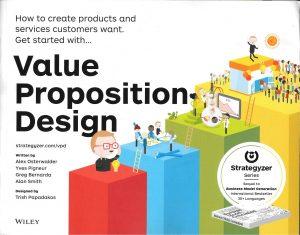The one sentence summary
You can design robust value propositions by using a proven mapping technique.
WHAT THE BOOK SAYS 
· This is how to create products and services customers really want.
There are four stages:
Canvas: map everything out as described and check the degree of fit.
Design: prototype possibilities, analyse potential customers thoroughly, and make choices about what is in and out of the value proposition.
Test: extract hypotheses, prioritise them, design tests, prioritise and run them, capture learnings and make progress.
Evolve: use the system to create alignment in your company, measure and monitor, constantly reinvent.
- The Business Model Canvas contains sections on which to map partners, activities, resources, customer relationships, channels, cost structure, and revenue streams. (For more on this, see Business Model Generation, their previous book).
- Within the Value Propositions section lies the Value Map, which contains a list of all the products and services a value proposition is built around, gain creators for your customers, and pain relievers that alleviate customer pains.
- The customer segments section contains the customer profile, which covers gains (what customers want to achieve), jobs (what they are trying to get done), and pains (obstacles and bad outcomes)
WHAT’S GOOD ABOUT IT
- Great value propositions:
- Are embedded in great business models.
- Focus on the jobs, pains and gains that matter most to customers.
- Focus on unsatisfied jobs, unresolved pains, and unrealized gains.
- Target few jobs, pains, and gains, but do so extremely well.
- Go beyond functional jobs and address emotional and social jobs.
- Align with how customers measure success.
- Focus on jobs, pains and gains that a lot of people have or that some will pay a lot of money for.
- Differentiate from the competition on jobs, pains and gains that customers care about.
- Outperform the competition substantially on at least one dimension.
- Are difficult to copy.
- To generate one, complete the following: Our X help(s) Y who want to Z by A and B (unlike C).
WHAT YOU HAVE TO WATCH
- This is a highly visual system so it makes a lot more sense when you map everything out physically.
